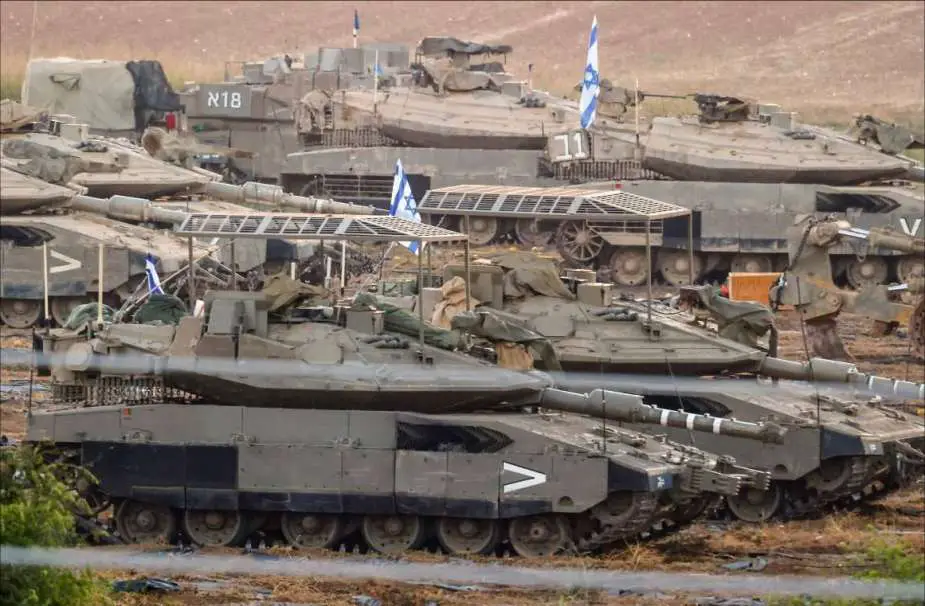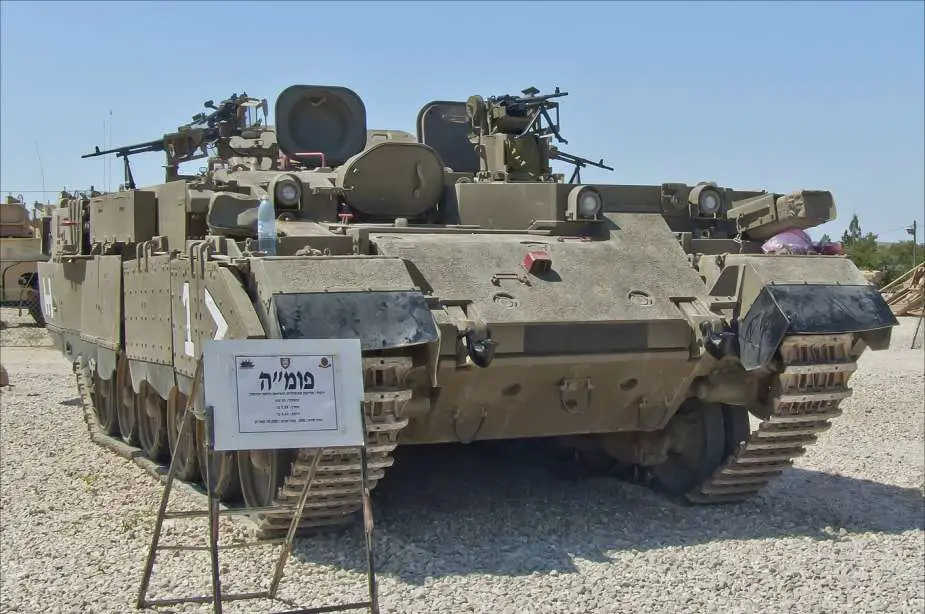Breaking news
Israeli Army conducts first tank raid in Northern Gaza Strip.
As reported by the Israel Defense Forces (IDF) on October 26, 2023, Israeli forces, led by the Givati Brigade from Division 162, conducted a nighttime tank raid in the Northern region of the Gaza Strip. This operation involved infantry units, Merkava Mk.4 tanks equipped with anti-drone defenses, Puma heavy armored engineering vehicles, and D9R armored bulldozers.
Follow Army Recognition on Google News at this link

The armored raid led by the IDF included the use of Merkava Mk.4 tanks, Puma armored engineering vehicles, and D9R armored bulldozers (Picture source: IDF)
This raid was part of the IDF's preparations for an impending ground offensive in Gaza. During the operation, D9R armored dozers and Puma engineering vehicles were used to clear the path, while Merkava Mk.4 tanks provided protection against potential attacks by Hamas squads. According to the IDF, during this operation that lasted several hours, Division 162 identified and destroyed infrastructure and anti-tank-guided missile launch sites used by Hamas militants. Additionally, five Hamas members attempting to assault the armored convoy were eliminated. Israeli forces completed the raid, met their objectives, prepared the terrain for subsequent operations, and withdrew without any reported casualties.
The operation's success is seen as a step toward preparing the terrain for future operations in the region. It is important to note that the IDF has been urging Palestinians to evacuate from northern Gaza as they intensify airstrikes in the Gaza City area, indicating a potential major ground incursion in the coming days.
This ground operation is one of the latest developments in a series of military actions between Israel and Hamas. Israeli officials have vowed to prevent further attacks that threaten the country's security, particularly in response to the attack by Hamas militants on October 7, which resulted in the deaths of approximately 1,400 people.
The situation in the Gaza Strip has been escalating for nearly three weeks, with Israeli forces conducting airstrikes targeting Hamas militants. Israel has also called up 300,000 reservists and stationed troops near the Gaza border in preparation for a ground offensive.
Israeli Prime Minister Benjamin Netanyahu confirmed these preparations, stating that Israel is readying itself for a ground invasion. However, he refrained from providing specific details regarding the timing, scale, and approach of the operation.

Merkava Mk.4 Main Battle Tanks equipped with anti-drone cages (Picture source: Vivek Singh/Twitter)
The Merkava Mk.4 Main Battle Tank (MBT) was introduced into service with the Israel Defense Forces (IDF) in 2004. Designed to fulfill various combat roles, it can transport infantry, a command group, or stretcher patients alongside its regular crew. The tank's features include the capability to engage moving targets while on the move, displaying a high probability of hits against attack helicopters using standard anti-tank munitions.
The tank's armament includes a 120 mm smoothbore gun, with the capacity to fire various types of 120 mm ammunition. It is complemented by a secondary armament, including a 7.62 mm coaxial machine gun, a 7.62 mm machine gun on the turret roof, and a 60 mm breech-loaded mortar. The tank's design and protection have been upgraded, featuring an all-electric turret, improved roof protection, modular ballistic protection, and the Trophy active protection system, which creates a protected zone around the tank, intercepting incoming threats.
The Merkava Mk.4 MBT has several variants: the LIC variant is equipped with a 12.7 mm coaxial machine gun, and also features a protective mesh for safeguarding vulnerable areas like optics and exhaust ports. The Merkava Barak variant introduces an advanced artificial intelligence mission computer to reduce crew workload and enhance target acquisition accuracy. The Merkava Windbreaker variant incorporates the Trophy Active Protection System (APS), providing significant protection against a range of threats, including RPG rockets.
The Merkava Mk.4 is powered by a V12 diesel engine, providing 1,500 hp, offering increased power compared to its predecessor, the Merkava 3. Its mobility is facilitated by a suspension system with rubber-tired roadwheels, ensuring maneuverability. The tank features a modern fire control and sighting system, including computerized ballistic calculations and advanced FLIR and TV channels for day and night operations. It also incorporates a Battle Management System (BMS) for effective communication and mission planning.
Additionally, the Merkava 4 has been adapted to include an anti-drone cage, referred to as the "Cope Cage" or "Protective Canopy." This adaptation is in response to the increasing threat posed by drones in modern warfare, as observed during the Russian-Ukrainian conflict. The cage is mounted on the tank's turret roof and is designed to protect against aerial attacks, including drones and loitering munitions.

The Puma armored engineering vehicle is armed with 7.62 and 12.7 machine guns, a 60mm mortar, and could also be armed with a rocket launcher carrying 20 rockets (Picture source: Wikimedia)
The Puma, also known as the Foma, is an armored combat engineering vehicle used by the Engineering Corps of the Israeli Defence Forces since the early 1990s. Weighing in at 50 tons, it accommodates a crew of up to eight individuals and can achieve a maximum speed of 45 km/h. The Puma is constructed using the modified hull of the Sho't, which is a British Centurion tank variant.
This heavily armored vehicle weighs 51 tons, including additional armor weighing 15 tons, along with reinforced blades, providing it with substantial resistance to gunfire and explosives. It plays a critical role in addressing enemy fortifications and tunnels, which are frequently employed by groups like Hamas.
This engineering vehicle could be equipped with various equipment depending on the mission, such as a mine plow, a towed bridge, a mine roller, a dozer blade, but also the Israeli Carpet mine-clearing system, manufactured by Rafael, which includes 20 rockets carrying fuel-air explosive warheads that are fired singly or in a single salvo, effectively neutralizing both mines and enemy infantry. The Puma can be also fitted with an electromagnetic mine neutralization system that detonates roadside bombs or jams detonation signals. A crane can be mounted at the rear.
The Puma is heavily armed, as its armament includes three 7.62 mm FN MAG 58 machine guns, a M2 Browning 12.7mm heavy machine gun, a Rafael Overhead Weapon Station (OWS) remote-controlled turret armed with a Rafael MAG (a MAG manufactured in Israel under license), a 60 mm Soltam mortar and two TAAS IS-6 smoke grenade launchers.
The vehicle is powered by an AVDS-1790-6A V12 engine offering 908 hp, which originates from the Merkava Mk.1 Main Battle Tank. Some vehicles are also equipped with tracks and suspension similar to that of Merkava Mk.1 and Mk.2. The vehicle measures 7.55 m in length, 3.38 m in width, and 2.65 m in height.

The D9R, weighing 62 tons, is equipped with an armored cabin and anti-RPG grilles (Picture source: Wikimedia)
The D9R, also referred to as 'Doobi' or 'Teddy Bear,' is a modified armored bulldozer originally based on a Caterpillar model, tailored for specific use in urban settings. Its main purpose is to clear enemy fortifications and tunnels, notably addressing the threats posed by groups like Hamas. With 15 tons of additional armor and a reinforced blade, the D9R is highly resistant to gunfire and explosives, making it a valuable asset for such hazardous tasks.
The D9R received notable upgrades in 2015, including the addition of an armored cabin and 'slat armor,' designed to offer enhanced protection against rocket-propelled grenades (RPGs), which are commonly employed by Hamas. The slatted armor deflects the sensitive end of RPGs, reducing their impact effectiveness. This formidable vehicle measures 8 meters in length, 4 meters in height, and 4.5 meters in width, with a weight of 62 tonnes. It is powered by a 405 horsepower Cat 3408C engine, capable of handling more than 70 tons, facilitating its maneuverability in urban settings, including areas where concealed tunnels may exist. The D9R is a vital asset in complex urban warfare environments, primarily for tunnel clearance operations.
In anticipation of a potential large-scale incursion into the Gaza Strip, the Israeli military is preparing to navigate the challenging urban landscape, characterized by intricate tunnels, explosive hazards, and sniper positions. The D9R armored bulldozer is expected to play a significant role, particularly in crushing the tunnels used by Hamas. This specialized vehicle can safely handle mine and improvised explosive device (IED) disposal, rendering it almost impervious to attacks.
The Israeli armored Caterpillar D9R more in detail
Standing at a towering height of 4 meters and weighing approximately 70 tonnes, these formidable machines boast robust grid armor that grants them the ability to withstand certain land mines. In some instances, IDF technicians have affixed a machine gun above the cockpit of bulldozers, enhancing their defensive capabilities alongside the already installed smoke projectors and other grenade launchers. The passenger compartment, safeguarded by bulletproof windows, can comfortably accommodate two operators. To manipulate these colossal machines, soldiers aspiring to join military engineering units must undergo an intensive eight-week training program.
Originating in the United States, these bulldozers have been produced since 1955 by the Texan manufacturer Caterpillar and have swiftly found utility in both American and Israeli military operations. During the Vietnam War, they were deployed for tasks such as forest clearance and road construction. In the Middle East, their inaugural missions took place on the Golan Heights during the Yom Kippur War in October 1973. In a notable instance, the D9 bulldozer breached enemy defenses, enabling IDF paratroopers to retake Mount Hermon, a strategic location previously captured by Syrian commandos. Notably, at that time, the IDF bulldozers were not yet armored; this enhancement was introduced in 1986. Since then, a series of upgrades and modifications have been implemented in response to evolving conflict scenarios. In 2005, in response to the escalating threat posed by shaped charge rocket attacks, the D9 was equipped with cage armor to mitigate the effects of rocket launcher fire.
Through Zoko Enterprises, an Israeli company authorized by Caterpillar, prominent defense firms such as Elbit Systems and Ramta, a subsidiary of Israel Aerospace Industries, collaborate with the Israeli government to leverage the technological prowess of their bulldozer fleet. Since the Second Lebanon War in 2006, IDF soldiers have been able to remotely operate the D9N, an unmanned bulldozer of the same model, known as "Raam HaSchachar" or "thunder of the dawn." During Operation Cast Lead, which concluded in December 2009, approximately one hundred D9 bulldozers played a pivotal role, particularly in the destruction of outposts and bunkers. In August 2019, Elbit Systems won a contract from the Israeli Ministry of Defense, further reinforcing the D9's resilience against anti-tank missiles. Headquartered in Haifa, this defense-focused company equips bulldozers with the Iron Fist system. When an imminent threat emerges, the device deploys an interceptor, akin to a small rocket, which intercepts and deflects or neutralizes incoming projectiles. Additionally, the Iron Fist cannon is capable of countering drone attacks.



















